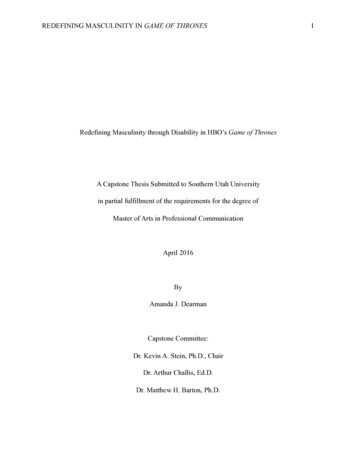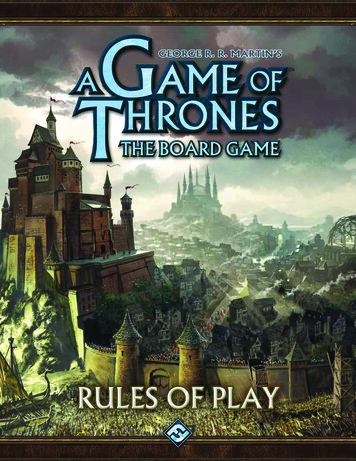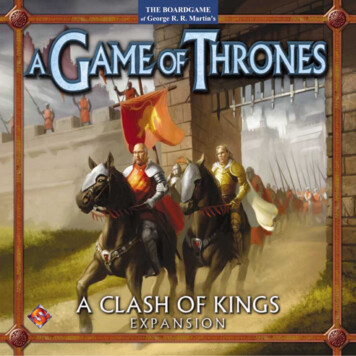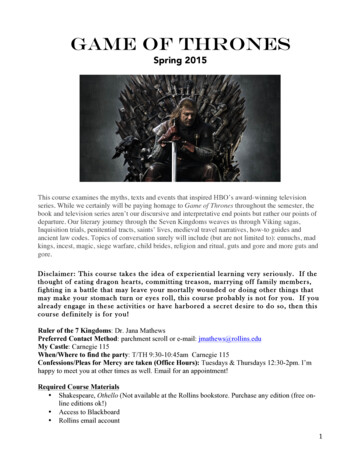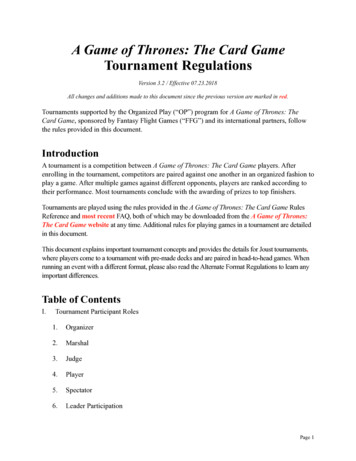
Transcription
A Game of Thrones: The Card GameTournament RegulationsVersion 3.2 / Effective 07.23.2018All changes and additions made to this document since the previous version are marked in red.Tournaments supported by the Organized Play (“OP”) program for A Game of Thrones: TheCard Game, sponsored by Fantasy Flight Games (“FFG”) and its international partners, followthe rules provided in this document.IntroductionA tournament is a competition between A Game of Thrones: The Card Game players. Afterenrolling in the tournament, competitors are paired against one another in an organized fashion toplay a game. After multiple games against different opponents, players are ranked according totheir performance. Most tournaments conclude with the awarding of prizes to top finishers.Tournaments are played using the rules provided in the A Game of Thrones: The Card Game RulesReference and most recent FAQ, both of which may be downloaded from the A Game of Thrones:The Card Game website at any time. Additional rules for playing games in a tournament are detailedin this document.This document explains important tournament concepts and provides the details for Joust tournaments,where players come to a tournament with pre-made decks and are paired in head-to-head games. Whenrunning an event with a different format, please also read the Alternate Format Regulations to learn anyimportant differences.Table of ContentsI.Tournament Participant r6.Leader ParticipationPage 1!
7.Conducta.II.Unsporting ConductTournament Materials1.Organizer Materials2.Player Materials3.a.Deck Buildingb.Deck Listsc.Card Sleevesd.Lost and Damaged Cardse.TokensLegal ProductsIII. Tournament Play1.Tournament Setup2.Game Setup3.Missed Opportunities4.Taking Notes and Outside MaterialIV. Tournament Concepts1.Tournament Round Times2.Pairings3.a.Swiss Roundsb.Progression Cutc.Single Elimination RoundsEnd of Rounda.Going to TimePage 2!
4.Tournament Pointsa.V.TiebreakersTournament Structures1.Basic Structure2.Advanced Structure3.Custom StructureVI. Tournament Tiers1.Relaxed2.Formal3.PremierTournament Participant RolesEvery person present at a tournament is a participant. Participants fulfill specific roles based ontheir responsibilities to the tournament. All participants share the responsibility of acting in arespectful manner toward one another. Please read the Fundamental Event Document for adetailed explanation of these roles. Participant leader roles are: organizer, marshal, and judge.Other roles include player and spectator.OrganizerAn event must have exactly one organizer. The organizer is responsible for the oversight of theentire event, including both planning and execution. If the organizer does not assign a marshalfor the event, the organizer must perform the responsibilities of the marshal role.MarshalAn event may have any number of marshals, including none. A marshal is an expert on thegame’s rules and regulations and the final authority on their application during a tournament. Amarshal also determines if unsporting conduct has occurred and what the appropriate remedy is,referring any recommendations for disqualification to the organizer. When a marshal is notactively performing his or her duties, he or she is a spectator and should communicate thischange in status clearly.Page 3!
JudgeAn event may have any number of judges, including none. A judge is well-versed in the game’srules and regulations. A judge’s responsibilities include assisting players to resolve disputes andanswering questions regarding the game’s rules. When a judge is not actively performing judgeduties, he or she is a spectator and should communicate this change in status clearly.When a judge is observing a game or an issue is brought to his or her attention, the judge shouldinform players when they are not following the game rules. Players have an initial opportunity toresolve any situation among themselves, but any player may alternatively ask the judge to makea ruling. At a player’s request, a marshal can review a judge ruling and provide a finaldetermination.PlayerA player is an individual that plays A Game of Thrones: The Card Game at the event. A playermust bring all components they need to play a game of A Game of Thrones: The Card Game.When a player is not actively engaged in a game of A Game of Thrones: The Card Game, he orshe is a spectator.SpectatorA spectator is any individual physically at a tournament not actively engaging in another role.Spectators must not disturb an ongoing game, and cannot provide any input or assistance to playersduring their games. If a spectator believes they have witnessed a breach of the rules in a game theyare watching, other than a missed opportunity, he or she may bring it to the attention of a leader.Leader ParticipationA leader may participate as a player in a Relaxed tier tournament for which he or she is responsibleonly if there is at least one other leader present. Additional leaders must be announced at thebeginning of the tournament and are responsible for all rulings for games in which the firstleader is playing. If two leaders play one another, the marshal is responsible for any rulings duringthe game.During Formal and Premier tier tournaments, leaders cannot participate as a player. Leaders forFormal and Premier tournaments are expected to commit their full attention to overseeing the event.ConductAll tournament participants are expected to act in a respectful manner during a tournament. Ifplayers have a dispute during a competition and cannot resolve it themselves, they must call for ajudge to resolve it and provide any rulings that are needed. All card interpretations during atournament are a marshal’s responsibility, and he or she may overrule the rules documents whena mistake or error is discovered.Page 4!
Unsporting ConductPlayers are expected to behave in a mature and considerate manner and to play within the rulesand not abuse them. This prohibits intentionally stalling a game for time, placing componentswith excessive force, inappropriate behavior, treating an opponent with a lack of courtesy orrespect, cheating, etc. Collusion among players to manipulate scoring is expressly forbidden.The organizer, at his or her sole discretion, may remove players from the tournament forunsporting conduct.Tournament MaterialsThere are many materials and game components needed to facilitate a tournament. The organizerand players are both responsible for supplying certain items.Organizer MaterialsIn addition to arranging a location, the organizer is responsible for securing tables and chairs for eachplayer. The organizer should have table numbers on hand or some other method of demarcation soplayers can easily find their seats at the beginning of each tournament round. The organizer isresponsible for having blank deck lists and pens available if they are required for the event.Finally, the organizer is also responsible for having all required rules documents on hand forreference during the event. This includes the A Game of Thrones: The Card Game RulesReference, A Game of Thrones: The Card Game FAQ, A Game of Thrones: The Card GameTournament Regulations (this document), and any Event Outline or other document relevant tothe event. Most of these documents can be found on the A Game of Thrones: The Card Gamewebsite at FantasyFlightGames.com/AGoT-LCG.Player MaterialsPlayers are responsible for bringing all of the game components they need to play a game of AGame of Thrones: The Card Game. This includes all cards, sleeves, and tokens. They shouldmake sure that they have a legal deck. When a deck list is required, players should bring acompleted list or arrive at the venue early to fill one out.Deck BuildingEach player must build one draw deck and one plot deck to use in a tournament. Each draw deckmust contain one faction card and a minimum of 60 other cards. A player may also include oneagenda card that does not count toward the 60-card minimum. There is no maximum size for thedraw deck. However, players must be able to shuffle their deck without assistance and within areasonable amount of time. Each plot deck must contain exactly seven cards.Players must use the same draw deck and plot deck for the duration of the tournament.Page 5!
Decks must conform with the Joust Restricted List in the A Game of Thrones: The Card GameFAQ This document can be found on the A Game of Thrones: The Card Game page of ourwebsite at FantasyFlightGames.com/AGoT-LCG.Deck ListsSome events require players to submit deck lists, including their name and all associated cards inboth of their decks to the organizer before the start of the tournament.If a player includes a card in his or her deck with the same name as a different card that couldlegally be in the deck, he or she must uniquely identify that card on his or her deck list. Therecommended way to uniquely identify a card is by including the full name of the product inwhich the card appeared in parenthesis. A player can ask a leader for specific instructions if theyare unsure of the best method to uniquely identify a card.Unique identification example: Veronica includes Jon Snow in her draw deck, using the versionfrom the Core Set. However, there are other cards with the name Jon Snow but different attributesand abilities in the game, so Veronica writes “Jon Snow (Core Set)” on her deck list.If a leader discovers a player’s deck list is missing appropriate information, he or she should findthat player immediately and update the deck list based on the cards the player is using. If thiswould result in a significant and potentially advantageous change, the leader should considerinvestigating for possible cheating.Card SleevesPlayers are required to sleeve each draw deck and plot deck in opaque card sleeves for Formaland Premier events. Players may use different sleeves between decks, but all sleeves within asingle draw or plot deck must be identical in size, color, texture, and condition. At Relaxedevents, if a player is not using opaque card sleeves, he or she must make sure that all card backsin each of their decks have a uniform appearance. Players should bring a few spare sleeves foreach of their decks in case a card sleeve breaks or becomes unusable during a tournament.Lost and Damaged CardsIf a player loses a card during a tournament, he or she has an opportunity to find a replacement,if necessary. Any player that discovers they are missing a card at the beginning of a round shouldnotify a leader. The leader will give the player a short time extension to their game in order tofind a replacement. If the player cannot find a replacement within that time, they must concedethe game. If the player is unable to find a replacement by the start of the next round, they shouldbe removed from the tournament.During a game, if a player discovers they are missing a card from their deck, they mustconcede the game.Page 6!
If a player’s card becomes damaged during the course of a tournament, he or she has anopportunity to find a replacement. If the player cannot find a replacement, he or she uses a proxycard in its place for the remainder of the tournament. A leader will create the proxy, including thecard name, any information that is no longer legible or available on the damaged card, the nameof the leader who created it, and the date it was created. The original card must be kept facedownand nearby, available for reference when the proxy card is played.TokensTokens are representations of information about the game or game state. The presence of tokensis marked by one or more indicators. Indicators may also be used to represent multiple tokens, orother open or derived information.Typically, players use the cardboard tokens included in official product as indicators. However,players may choose to use other items as indicators, so long as they do not obscure significantcomponent information, are resistant to accidental modification, and their purpose of use is clear toboth players. The marshal is responsible for determining the legality of an indicator and its reasonableuse during a match if objected to by its owner’s opponent.Legal ProductsPlayers may use only official A Game of Thrones: The Card Game components in tournamentplay, with the following exceptions for third-party replacements: Tokens that do not obscure card informationDetermining the legality of any questionable third-party tokens is the marshal’s responsibility. Proxiesof cards are not allowed unless used under the rules of “Lost and Damaged Cards” on page 6.All A Game of Thrones: The Card Game components are legal for Standard Play tournaments,including official promotional cards, tokens, and other components given out at eventsor tournaments.For Relaxed and Formal events, all product is legal in North America upon the product's officialrelease. For Premier events, all product is legal in North America 11 days—typically the secondMonday—after the product's official release. Official dates will be updated on the ProductLegality page on our website (FantasyFlightgames.com/OP/Legality). Players outside NorthAmerica should check with their organizer to determine which products are tournament legal.Page 7!
Tournament PlayThis section provides information and considerations for playing a game of A Game of Thrones:The Card Game at a tournament.Tournament SetupBefore the tournament begins, the organizer must set up tables suitable for tournament play. Eachseat should be arranged so that players have enough space on the table to comfortably place allof their cards and tokens over the course of a game. In addition, the organizer should clearlycommunicate the details of the event to players ahead of time.Game SetupThe following steps must be performed before players can begin their first game eachtournament round.1. Players determine who is first player. This should be done by flipping a coin, rolling adie, or another random process.2. Each player reveals their faction card and agenda card—if they have one—in playerorder, placing them prominently in their play area.3. Players prepare the tokens they will need over the course of the game, placing them inpiles within easy reach.4. Each player places their plot deck facedown next to their faction card.5. Each player shuffles their deck thoroughly and presents it to their opponent. Theopponent may shuffle and cut the deck if desired. After the opponent has had a chance toshuffle the deck, each player places it within easy reach in their play area.6. Each player draws the top seven cards of their deck. Each player, in player order, maydecide to return those seven cards to their deck, shuffling the deck and presenting it totheir opponent again before drawing a new hand of seven cards. Players must keep theirsecond hand.7. Each player, in player order, may place up to 8 gold worth of character, location, andattachment cards from their hand as setup cards. Setup cards are placed facedown in aplayer’s play area.8. Players turn all setup cards faceup simultaneously. Then, in player order, each playerattaches their attachments and places any duplicates.9. Each player draws cards until they have seven cards in their hand.Once players complete setup, they must wait for a leader to announce the start of the roundbefore beginning their game. If the round has already begun, players may begin playingimmediately upon completing these steps.Page 8!
Missed OpportunitiesPlayers are expected to follow the game’s rules, remembering to perform actions and use cardeffects when indicated. It is all players’ responsibility to maintain a proper game state, and toensure that all mandatory abilities and game steps are acknowledged. If a player forgets to use aneffect during the timing specified by that effect, he or she cannot retroactively use it without theconsent of his or her opponent. Players are expected to act with respect and not intentionallydistract or rush an opponent with the intent of forcing a missed opportunity.Taking Notes and Outside MaterialPlayers cannot take notes or reference outside material or information during a tournamentround. However, players may reference official rule documents at any time or ask a judge forclarification from official rule documents. Official rule documents include all rules documentsand inserts available on the A Game of Thrones: The Card Game page of our website, thosefound in an A Game of Thrones: The Card Game product, or any portion thereof.Tournament ConceptsThe tournament concepts create the framework for any A Game of Thrones: The Card Gametournament.Tournament Round TimesEach tournament round of A Game of Thrones: The Card Game is a predetermined length, givingplayers a certain amount of time to complete their games. A leader should start the timer for atournament round after most players have found their seats and begun to set up. If a game has notconcluded when the time for a tournament round runs out, the players play through the nexttaxation phase (see “End of Round” on page 12). A tournament round’s length varies dependingon the type of round. Swiss Rounds: 55 minutes each Single Elimination Rounds (except Final): 55 minutes each Final Single Elimination Round: 120 minutesPage 9!
PairingsEach tournament round, players are paired with an opponent, against whom they play a game ofA Game of Thrones: The Card Game. The method of pairing may change based on what type ofrounds are being used. The organizer must announce the number and type(s) of rounds and whatsize any progression cuts will be before the start of the tournament.When necessary, a player may be assigned a bye instead of being paired against an opponent.That player receives a win for that round of the tournament. The rules for when to assign a bye toa player are detailed in the relevant sections below.Players should not be paired against the same opponent more than once during a single stage of atournament. In general, a stage of a tournament ends when a progression cut is made.If a player no longer wishes to continue playing, he or she can notify the organizer of their intent.The organizer will avoid pairing him or her in future rounds by dropping them from thetournament. Players are also dropped if they do not appear for a round within a reasonable timelimit in which they are paired, or if they are no longer able to play for another reason. Playerscan request that the organizer allow them to rejoin an event from which they were dropped, beingassigned unpaired losses for each round they did not attend. Players can rejoin an event onlyduring the same stage in which they left. Disqualified players are removed from the tournamentand cannot rejoin.Swiss RoundsMost A Game of Thrones: The Card Game tournaments use a Swiss pairing system that awardstournament points to the winner of each game. Each Swiss round pairs players in head-to-headmatches, attempting to pair players with the same number of tournament points together whilepreventing players from playing the same opponent more than once. At the end of Swiss rounds, thewinner of the tournament is the player with the most tournament points unless there are singleelimination rounds (see “Single Elimination Rounds” on page 11).For the first round of Swiss pairings, players are matched randomly against an opponent. Foreach round after the first, players are paired at random against another player with the samenumber of tournament points.To determine pairings, take the group of players with the most tournament points and pair themat random. If there is an odd number of players in that group, pair the remaining player with arandom player from the group of players with the next most tournament points. Then, pair allremaining players in the second group at random. Continue this until all players are paired.If there is an odd number of players in the tournament, a player at random receives the bye in thefirst round. In later rounds, if there is an odd number of players remaining in the tournament, thebye is given to the lowest ranked player who has not yet received a bye.Page 1! 0
Pairing example: John, Stella, and Laramy each have 15 tournament points, the most out of anyplayer in the tournament. John is paired against Stella. Because there are no other players with15 tournament points, Laramy is paired against a random player from the next highest scoregroup—in this case, players with 10 tournament points. Kyle is selected at random from playerswith 10 tournament points and is paired against Laramy.Progression CutMany A Game of Thrones: The Card Game tournaments set a predetermined number of rounds, atthe end of which all players that meet a certain performance criteria advance to the next stage ofthe tournament and all other players are dropped. This is commonly referred to as "making acut," and is often accompanied by a change in the type of tournament rounds and the start of anew stage in the tournament.These tournament regulations cover the type of cut used for the Basic and Advanced tournamentstructures: a standings-based cut to the top 4, 8, or 16 players. There are additional types ofprogression cuts detailed in the Fundamental Event Document, found on the A Game of Thrones:The Card Game page of the FFG website.If a player qualified for a standings-based cut drops from the tournament before any games areplayed during the next stage of the tournament, the next highest ranking player should be addedto the cut as the lowest ranked player in the cut.Player drop example: Steven finishes the Swiss rounds of a tournament in sixth place and makesthe top 8 cut but has a family emergency come up before the single elimination rounds begin. Heinforms the organizer that he must leave the tournament and then departs. The organizerimmediately calls over the ninth place player, Eve, and informs her that she may play in the top 8due to someone leaving. She accepts and is entered into the top 8 as eighth place. The formereighth place player moves to seventh place, and the former seventh place player moves to Steven’sspot at sixth place. Then the organizer pairs all eight players based on these new rankings.Single Elimination RoundsMany A Game of Thrones: The Card Game tournaments use single elimination rounds, in whichthe winner of each pairing remains in the tournament and the losing player is eliminated anddropped from the tournament. Elimination rounds are usually used after a progression cut to thetop 4, 8, or 16 players and continue until only one player remains and is named the winner.For the first round of single elimination that follows a progression cut, pair the highest rankedplayer against the lowest ranked player who made the cut. This is Game #1. Pair the secondhighest player against the second-lowest player who made the cut. This is Game #2. Continue inthis manner until all players are paired.Page 1! 1
For tournaments which begin with single elimination rounds, byes will need to be utilized for thefirst round if there are a number of players not equal to an exponential power of 2 (4, 8, 16, 32,and so on). Randomly assign byes to a number of players equal to the difference between theactual player count and the next-highest exponential power of 2. Then pair all remaining playersagainst each other at random. Assign each pairing and player with a bye a game number in arandom order, starting with Game #1.For additional elimination rounds, pair the winner of Game #1 against the winner of the lastpairing (the game with the highest number). This pairing is the new Game #1. If there are morethan two players remaining, pair the winner of Game #2 against the winner of the second-to-lastpairing (the game with the second highest number). This pairing is the new Game #2. Continuein this manner until all players are paired for the round.In further single elimination rounds, follow the same method until all players are paired.If a player drops from the tournament after single elimination rounds begin, that player’s currentopponent—or next opponent, if the player drops between rounds—receives a bye for the round.End of RoundEach tournament round ends in one of the following ways: Victory Condition: One player meets their deck’s victory condition. The player who meetstheir victory condition earns a win and their opponent receives a loss. Empty Draw Deck: If a player’s draw deck contains no cards, that player immediatelyreceives a loss and their opponent receives a win. Time: When time is called at the end of a tournament round, players must play through thetaxation phase of the current game round. If neither player has won, they follow the “Goingto Time" rules on page 13 to determine who receives a modified win. Concession: A player voluntarily concedes defeat at any point during the game. Theconceding player receives a loss and the opponent receives a win.Page 1! 2
Going to TimeIf neither player has achieved victory at the end of a round, they must follow the steps below, in order,to determine who receives a modified win. That player’s opponent receives a loss for the round.1. The player who needs the fewest power to achieve victory. If both players require thesame amount of power, proceed to step 2.2. The player with the most cards remaining in his or her draw deck. If both players havethe same number of cards remaining, proceed to step 3.3. The player who won dominance in the final round of play. If neither player wondominance in the final round, proceed to step 4.4. The player with the fewest characters in his or her dead pile. If both players have thesame number of characters in their dead piles, proceed to step 5.5. The player who was first player at the end of the game chooses a player to receive themodified win. The chosen player’s opponent receives a loss.End of Round Example: Time is called for the round. Dan and Emily are currently in thechallenges phase, so they finish the game round. Neither player wins by the end of the taxationphase, so they follow the rules for going to time. Based on step 1, Dan has 11 power and Emily has13 power. Emily only needs 2 more power for a victory, while Dan needs 4 more power. Since Emilyis closer to victory, she receives a modified win and Dan receives a loss.Tournament PointsPlayers earn tournament points at the end of each round. At the end of a tournament, the playerwith the most tournament points wins the tournament. In the case of a larger event, they areinstead used to determine who makes the cut to elimination rounds. Players earn tournamentpoints as follows: Win 5 tournament points Modified Win 4 tournament points Loss 0 tournament pointsPage 1! 3
TiebreakersIf two or more players have the same number of tournament points, tiebreakers are used todetermine each player’s standing within that group. Tiebreakers are used in the following orderuntil all players within that group have been given a standing. Strength of Schedule: A player’s strength of schedule is calculated by dividing eachopponent’s total tournament points by the number of rounds that opponent has played, addingthe results of each opponent played, and then dividing that total by the number of opponentsthe player has played. The player with the highest strength of schedule is ranked above allother players in the group not yet ranked. The player with the second-highest strength ofschedule is ranked second among all players in the group not yet ranked, and so on. Extended Strength of Schedule: A player’s extended strength of schedule is calculated byadding each opponent’s strength of schedule and then dividing by the number of opponentsthat player has played. The player with the highest extended strength of schedule is rankedabove all other players in the group not yet ranked. The player with the second-highestextended strength of schedule is ranked second among all players in the group not yetranked, and so on. Random: If any players are still tied after all other tiebreakers have been applied, thenthose players are ranked in a random order below any players already ranked in the group.Page 1! 4
Tournament StructuresThe structure of a tournament determines how many Swiss and single elimination rounds are used.All A Game of Thrones: The Card Game tournaments must use one of the following three types.Basic StructureThe basic tournament structure is designed to be very accessible, especially for newerparticipants. This structure provides a tournament experience that requires a modest commitmentof time and resources from organizers and players. The Basic Structure is used for StoreChampionship events.Number of RegisteredPlayersNumber of SwissRoundsSize of Cut4-83No Cut9-164No Cut17-244Top 425-405Top 441-445Top 845-766Top 877-1486Top 16149 and Above7Top 16Page 1! 5
Advanced StructureThe Advanced tournament structure caters to participants that enjoy competition. This structureprovides a robust tournament experience that requires a substantial commitment of time andresources from organizers and players. The Advanced Structure is used for RegionalChampionship events.Number of RegisteredPlayersNumber of SwissRoundsSize of Cut9-124Top 413-244Top 825-405Top 841-766Top 877-1486Top 16149-2886Top 32289-5127Top 32513 and Above8Top 32Custom StructureThe custom structure applies to all round structures other than the basic and advanced structures.Also included in the custom structure are tournaments that offer a number of rounds or size ofcut that does not change based on attendance. The Event Outline of official custom tournamentswill either include a specific structure tailored to that particular type of event or instruct theorganizer to design a structure and communicate it to participants. The Custom Structure is usedfor official Premier events, such as National, North American, European, and WorldChampionship events.Page 1! 6
Tournament TiersFFG’s OP events are broken into
A Game of Thrones: The Card Game Tournament Regulations Version 3.2 / Effective 07.23.2018 All changes and additions made to this document since the previous version are marked in red. Tournaments supported by the Organized Play ("OP") program for A Game of Thrones: The Card Game, sponsored by Fantasy Flight Games ("FFG") and its international partners, follow



